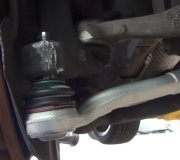Stop wasting your time. You listed so many mistruths that it's not going to be possible to straighten this out yourself. First of all, tie rod ends, ball joints, anti-sway bar links, and struts will not cause a vibration. If one of those parts is badly worn, it can allow a vibration to be worse, but all vibrations have to be caused by something that is rotating. That means, tires, wheels, brake rotors, and CV joints.
You said you replaced a tire yourself but didn't balance it. You can't possibly expect it to be in balance. There's a reason every tire purchase includes balancing. Drivers would all be complaining about the bouncing.
You also mentioned a "dip" in a tire. That is one of the potential characteristics of a broken belt. If that is on a front tire, you'll see and feel the oscillation in the steering wheel. If it's on a rear tire, you'll feel the back of the car shake left and right. You'll feel that in the seat too. Depending on how the belt breaks, you may feel the bouncing at only one speed, but also look for a slight steering wheel oscillation left and right as you drive slowly through a parking lot.
Your understanding of setting "toe" with the tie rod ends confuses me. You can't go by the number of turns the inner and outer are screwed together. No two tie rod ends are ever exactly the same. Once you do get one side close during the alignment, a quarter turn on one of them can send "total toe" from "perfect" to out-of-specs, along with tire wear. The only thing you can do yourself is if you start with a straight steering wheel and good alignment, then replace tie rod(s) on just one side, you can drive the car, and stop periodically to tweak that side until the steering wheel is straight again. That insures total toe is back very close to where it was. Now you can do the same thing on the other side if necessary. That will get total toe close enough that you can drive the car to an alignment shop. Be sure to keep the locknut or bolts tight when driving the car. If you leave them loose because you know you'll be stopping shortly to adjust them, the looseness will allow the threads to hammer against each other. That can lead to them pulling apart later.
If you replace a tie rod end on both sides at the same time, there's no way to know where to set them without alignment equipment. You can get it in the ballpark with a tape measure, and total toe, (the addition of toe on both sides), can be very close even if the steering wheel is off-center. That will be fixed during the alignment.
If you see a wheel that appears to be tipped in or out too much on top, that is "camber". That's the first of the three main alignment angles we set. Camber is not adjustable on GM front-wheel-drive cars as they come from the factory. A simple modification is needed to the lower mounting hole of the strut to make camber adjustable. When camber is changed, due to the geometrical relationship of the steering and suspension parts, toe is going to change a lot too. That's why toe is always the last of the three alignment angles we set.
GM front-wheel-drive cars are very forgiving of misadjusted camber as far as pulling to one side, so you can't use that as an observation or clue. Look for accelerated tire wear on the inner or outer edges of the tread. Camber that is out-of-specs on one wheel will affect tire wear on just that one tire. Camber can be out-of-specs on both wheels on the front or the rear, but each tire gets its own wear pattern.
Toe is a different story. Toe can be out-of-specs on one wheel or both. It's strictly the total toe that results in a bad wear pattern, but it always affects both tires on that axle, even when just one side is misadjusted. Look for a choppy, or "feather-edge" pattern. If you lightly run your fingers around the tire, you'll feel the raised and lower areas with your fingertips catching on the high spots of the blocks of tread, but you won't feel that when running your hand the other way. You'll get the same thing when you run your fingers from side to side across the tread. All of these things will be "read" by the person doing the inspection.
If you do suspect a broken tire belt, be very careful when running your fingers over the tread. Very often a broken belt is accompanied by the steel wires of the belt sticking out. Those really smart when they poke you.
There are some other somewhat common problems that can cause vibrations, but I don't think they apply here. Let's start with an inspection and alignment at a tire and alignment shop. They will also check for sagged chassis ride height. Ride height is critical to the geometry of the suspension system. Weak springs can make a vibration worse, or it can hide some symptoms leaving you with no way to know if there's a problem that's causing bad tire wear.
Check out this article too for an explanation of tire wear problems:
https://www.2carpros.com/articles/how-car-tires-work
You may see something that will give us a clue on where to go next. Let me know what you find up to this point.
Monday, June 17th, 2024 AT 2:24 PM


